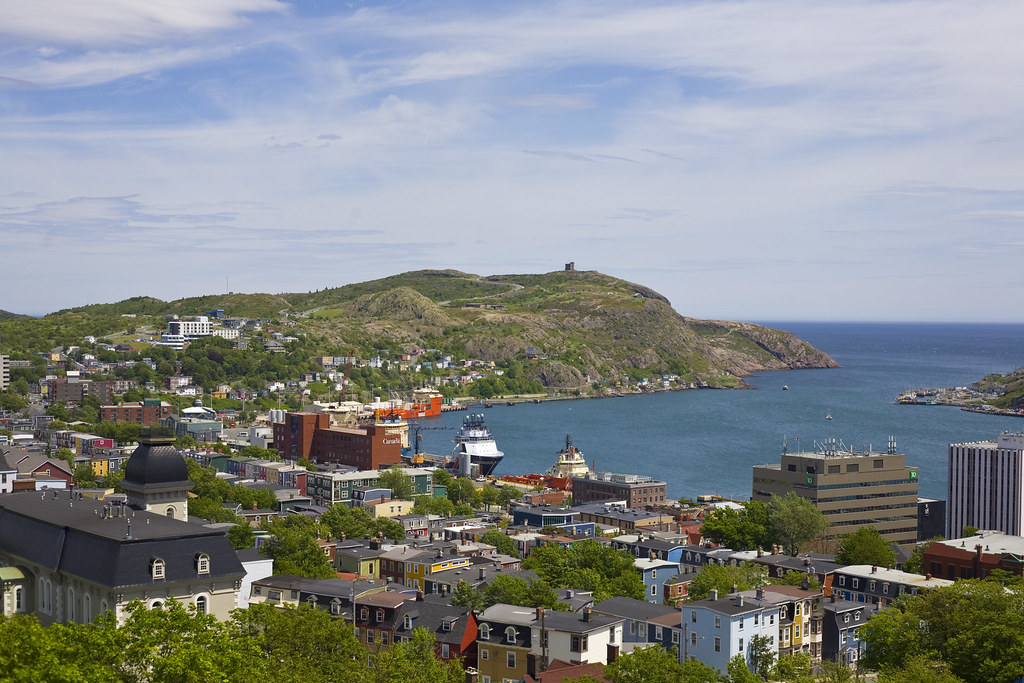I made an offer to the kind readers of Twelve Mile Circle back in September 2010. I said I’d be glad to explore and present geo-oddities for any location based on user suggestions. So I took this as a personal challenge and an opportunity to investigate areas that may have escaped my attention previously. “Katy” accepted my offer and requested an article on St. John’s, the provincial capital of Newfoundland and Labrador, Canada (map).

St John’s is a decently-sized place with a city population hovering around a hundred thousand within a wider metropolitan area about twice that size. My investigation should be quick and easy, I figured.
Pretty Normal
Katy thought St. John’s seemed like a nice little city, and indeed it was, but that’s the problem: there is little “odd” about it, geographic or otherwise. I was about to declare St. John’s the most vanilla town in Canada but I gave it one final push. I now have enough material to report a few unusual features.
The closest I’d come previously was my Mt. Pearl Mystery, which wasn’t an article about St. John’s per se but about an adjacent town. That became a recurring theme as I conducted my research. I found lots of almost strange or nearby odd but not much material directly within the city proper.
Any Superlatives?
For example, some call St. John’s “North America’s Oldest City.” That’s a fascinating claim but it comes with a lot of baggage. First, one has to ignore the universe of non-English settlements. Second, one has to discount other English settlements founded prior to St. John’s including nearby Cupids Colony located elsewhere on the Avalon Peninsula. Technically Cupid’s Colony doesn’t qualify as a “city” as defined. See what I mean?
So let’s explore another superlative. Some call St. John’s “the most easterly spot in North America.” However, Greenland generally qualifies as part of North America. But maybe it’s the most easterly spot on continental North America? That doesn’t work either. St. John’s is located on Newfoundland, an island, which makes it just as tenuous a claimant as Greenland. The best that can be said is that St. John’s is the most easterly spot in Canada. That happens at Cape Spear and I guess that’s a fairly decent geo-oddity.
This geographic placement does put St. John’s a lot closer to Europe than most of North America and that allowed it to carved a nice historical niche for itself. Guglielmo Marconi received the first transatlantic wireless message here. Also, Alcock and Brown departed from St. John’s on the first successful non-stop transatlantic airplane flight in 1919 (eight years before Charles Lindbergh did it solo from the U.S.).
Major Endpoint
The Trans-Canada Highway ends at St. John’s at the spot shown above. Departing here, a traveler would have to drive another 7,821 kilometres (4,860 miles) before arriving at the opposite end in Victoria, British Columbia. However, can St. John’s be considered part of a single transnational route if a 177 km ferry ride is required to connect Newfoundland to the mainland?
I will grant that a definite oddity exists here although not a logical one. I can’t understand why Vancouver Victoria has a mile zero marker at its terminus but St. John’s refers to their endpoint as mile one. St. John’s even has a sports complex called the Mile One Centre as a tribute. Why don’t the two cities agree?
Inclement Weather
We can salvage a few other oddities. Let’s talk about the weather. Natural Resources Canada says, “St John’s, Newfoundland and Labrador is the foggiest city in Canada with 121 days every year with fog. It is also the windiest city with an average annual wind speed of 24 kilometres per hour and has the most days of freezing precipitation with 38 days per year.” Well, maybe we shouldn’t dwell on the weather. Moving right along…
A U.S. Flag?
Why is there a United States flag flying over St. John’s? There are already enough misguided people who seem to believe that portions of Canada fall within U.S. territory — not people who read this blog of course — so an image such as this will feed into their conspiracy theories.
Actually, this is the United States Armed Forces Monument at the site of the former Pepperrell Air Force Base, which operated between 1941 and 1960. It began during the earlier days of World War II before the United States entered the conflict. The U.S. traded fifty surplus Navy destroyer ships to the United Kingdom in return for leases at several strategic locations, including this one at St. John’s.
Port Wine
I found one other geo-oddity with an historical twist in St. John’s, the Newman Wine Vaults (map).

As the story goes, a ship bound from Portugal to England in the Seventeenth Century ran into repeated troubles. The ship slipped its moorings while at port, evaded pirates, blew far off-course in a storm, and finally sailed deep into the North Atlantic Ocean as winter approached. The captain decided to seek safety in St. John’s Harbour until the weather improved. He unloaded his cargo of port wine at dockside cellars until he could return to England the following spring. Connoisseurs noticed that aging significantly improved the wine.
I’m not sure I believe the story entirely (it sounds like the captain and crew might have been sampling their cargo in transit) but it became a successful marketing gimmick. Lots of port wine journeyed from Portugal to England via the St. John’s detour for more than two centuries. I guess people figured out eventually that vintners could age Port closer to home, but the Newman company kept the ruse going for multiple generations.
Well Katy, I hope that meets your expectations. You gave me quite the challenge but I finally managed to salvage something in the end! I also learned a lot more about St. John’s than I expected, too.
Readers should feel free to keep suggestions coming.

Leave a Reply